The Pavo Galaxy is an intermediate spiral galaxy located approximately 23.63 million light years away in the southern constellation of Pavo (the Peacock). It is listed as NGC 6744 in the New General Catalogue and Caldwell 101 in the Caldwell catalogue. With an apparent visual magnitude of 9.14 and an apparent size of 20 by 12.9 arcminutes, the galaxy can be observed in amateur telescopes.
NGC 6744 is believed to look nearly identical to our own Milky Way galaxy. It is the nearest and brightest galaxy in the southern celestial hemisphere that has a morphological type similar to the Milky Way. However, the Pavo Galaxy is more massive than our galaxy. It has a stellar mass of 5.92 x 1010 M☉ (solar masses).
With a diameter of 171,800 light-years, the Pavo Galaxy is about twice the size of our galaxy. It is one of the largest spiral galaxies in the local universe. It resides within the Virgo Supercluster, which also contains the Virgo Cluster and the Local Group of galaxies, the home of the Milky Way and Andromeda galaxies. NGC 6744 belongs to the Pavo group of galaxies.
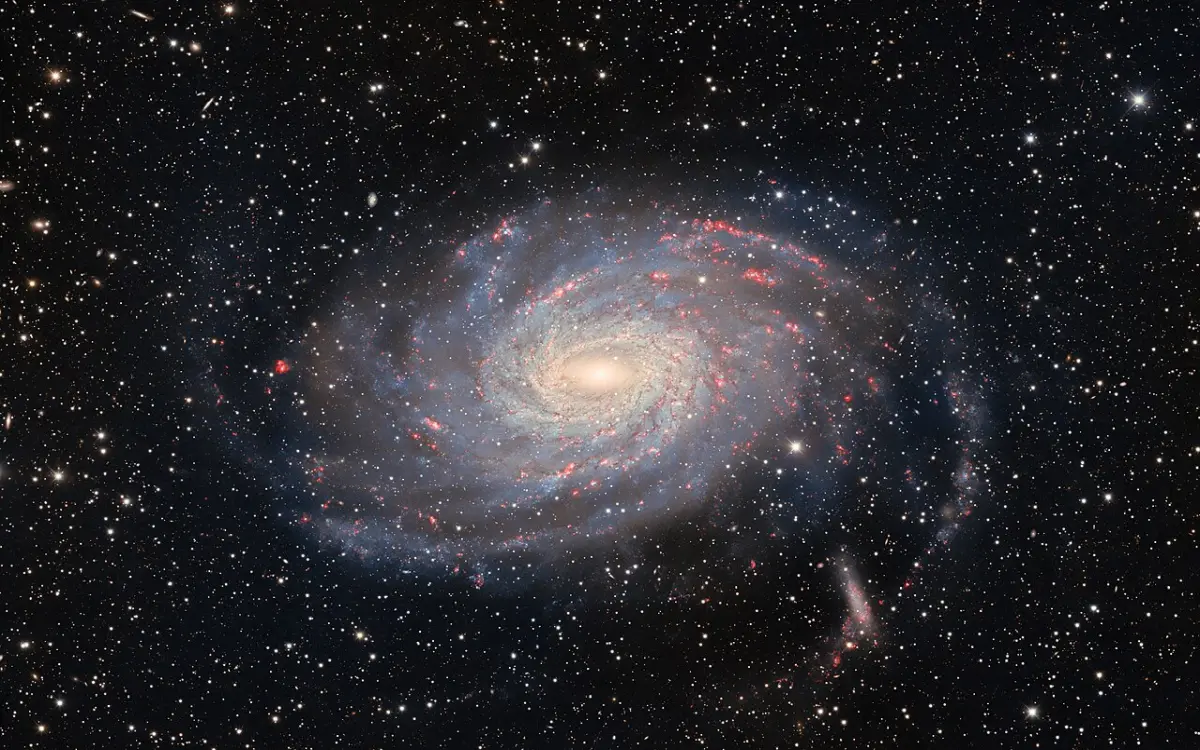
Behold NGC 6744, a spiral galaxy bearing similarities to our home galaxy, the Milky Way. This cosmic twin is captured here in stunning detail by the Dark Energy Camera (DECam) on the Víctor M. Blanco 4-meter Telescope at the U.S. National Science Foundation Cerro Tololo Inter-American Observatory (CTIO), a Program of NSF NOIRLab in Chile. Located around 30 million light-years away in the constellation Pavo, NGC 6744 exhibits a luminous core and spiral arms spanning 175,000 light-years across, a larger but similar anatomy to our Milky Way. Moreover, to the lower right of NGC 6744, at the end of the spiral arm, is a faint blob. This is its companion galaxy known as NGC 6744A. The companionship between these galaxies is analogous to that between the Milky Way and its dwarf companion the Large Magellanic Cloud. Though it’s impossible to get an external view of our galaxy, these similarities offer insight into how the Milky Way might look to a distant observer.This is one of the deepest images of NGC 6744 ever taken, and keen observers can spy the faint extended arm on the left hand side of the galaxy — rarely visible in most images.This image is part of the DESI Legacy Imaging Surveys, an ambitious effort to construct the largest 3D map of the night sky with the DOE-built DECam on the Blanco Telescope at NSF CTIO and other Programs of NSF NOIRLab. Image credit: Dark Energy Survey/DOE/FNAL/DECam/CTIO/NOIRLab/NSF/AURA Image processing: R. Colombari & M. Zamani (NSF NOIRLab) (CC BY 4.0)
The Pavo Galaxy has an elongated central region and impressive flocculent spiral arms with a high rate of star formation, around 6.8 M☉ (solar masses) per year. The galaxy’s faint northernmost arm curves away from the galaxy’s main body and towards the small irregular galaxy LEDA 62815 (PGC 62815). Also catalogued as NGC 6744A, the small companion galaxy appears heavily distorted by the interaction with its larger neighbour. It bears a passing resemblance to the Large Magellanic Cloud (LMC), a smaller satellite galaxy of the Milky Way. LEDA 62815 appears as a blob in the outer spiral arm of NGC 6744.
The Pavo Galaxy has an active galactic nucleus (AGN) and is classified as a LINER galaxy. The galaxy’s core hosts a low-ionization nuclear emission-line region (LINER). The LINER nucleus was identified based on observations with the Integral Field Unit of the Gemini South Multi-Object Spectrograph in 2014. The study was published in The Astrophysical Journal in 2018.
The team of astronomers who authored the study, led by Patricia da Silva, Institute of Astronomy, Geophysics and Atmospheric Sciences of the University of São Paulo (IAG/USP), Brazil, also found that the galaxy may have gone through a merger about a billion years ago. The astronomers identified a gaseous rotating disk that was not aligned with the stellar disk in NGC 6744. They concluded that the central AGN was likely more luminous in the past.
LINER-type galactic nuclei are characterized by spectral line emission from neutral or weakly ionized atoms. The energy source that ionizes the gas in the core regions of LINER galaxies may be either central supermassive black holes or star formation regions.
Located in the southern sky, the Pavo Galaxy is largely invisible to northern observers. Like many other objects listed in the Caldwell catalogue, it can be spotted in a small telescope.
The Simbad database lists NGC 6744 as a member of three groups of galaxies (with more or less the same members). A 2007 study placed it in the galaxy group [CHM2007] LDC 1321 along with the lenticular galaxy NGC 6684 and the elliptical galaxy NGC 6673.
Studies published in 2008 and 2013 list the three galaxies as members of the group [TSK2008] 347, along with ESO 104-22, IC 4951, and IC 4824.
In 2015 and 2016, NGC 6744, NGC 6684, NGC 6673, IC 4824, and ESO 104-44 were listed as members of the group [T2015] nest 201054.
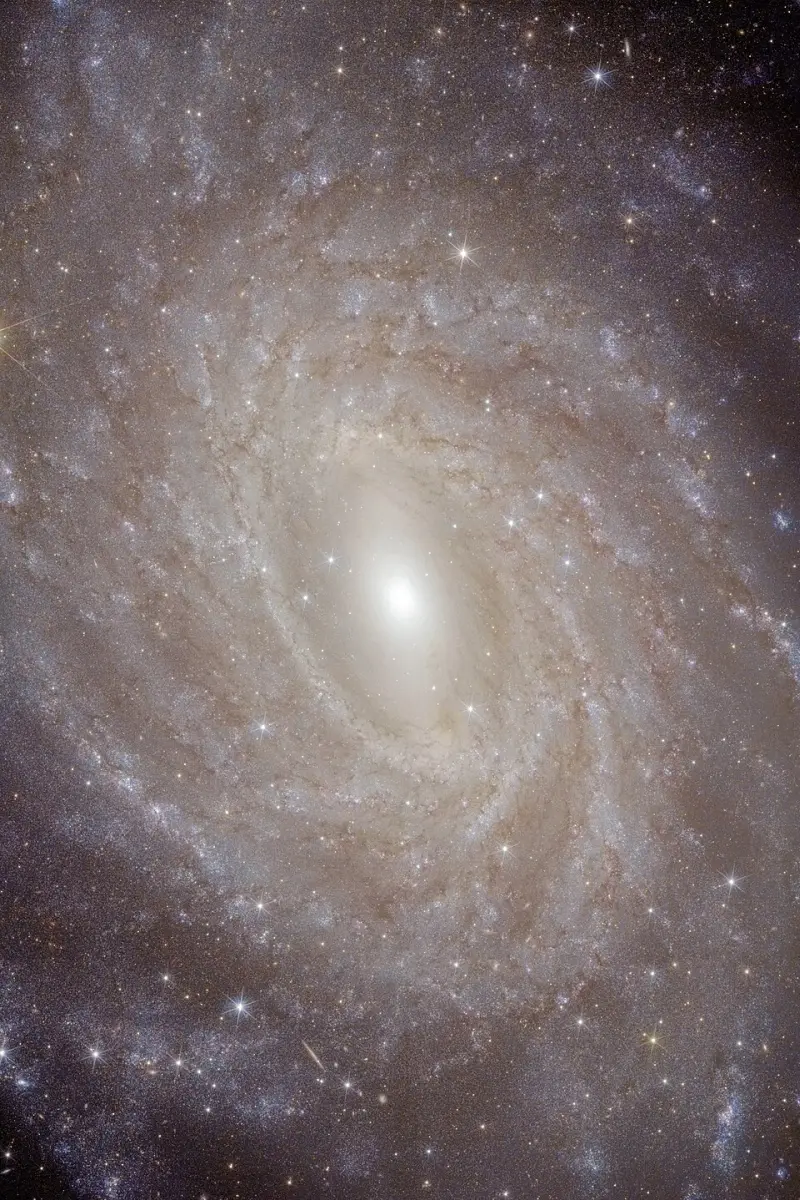
This image is released as part of the Early Release Observations from ESA’s Euclid space mission. All data from these initial observations are made public on 23 May 2024 – including a handful of unprecedented new views of the nearby Universe, this being one. This image is a higher resolution close-up cutout from a larger frame featuring the spiral galaxy NGC 6744. This frame shows the galaxy’s bulge and disc in detail. The central bulge is composed mostly of older, lower-mass stars, while the spiral arms host a diversity of stars. Most of NGC 6744’s star formation occurs in these arms, and this is marked by trails of bright, hot, blue-hued stars. Image credit: European Space Agency (CC BY-SA 3.0 IGO)
Facts
The Pavo Galaxy was discovered by the Scottish astronomer James Dunlop on June 30, 1826. Dunlop observed the galaxy from the Parramatta Observatory in New South Wales, Australia.
The galaxy has a velocity of 802 ± 3 km/s with respect to the cosmic microwave background, which translates into a Hubble distance of 38.6 ± 2.7 million light-years. However, 21 measurements that are not based on redshift give the closer distance of 23.63 million light-years.
Two supernovae were detected in the Pavo Galaxy in the recent decades. The Type Ic supernova SN 2005at was spotted by R. Martin and Berto Monard on March 15, 2005. It shone at magnitude 16.
The Type Iax supernova SN 2024vjm was discovered by the BlackGEM array at the La Silla Observatory in Chile on September 13, 2024. It is believed to have been the nearest supernova of this type. Type Iax supernovae occur in binary systems in which a white dwarf accretes mass from a more massive companion. Once it reaches the critical Chandrasekhar mass, the white dwarf undergoes a runaway reaction, triggering a supernova event. However, unlike regular Type Ia supernovae, which completely disperse the white dwarf, Type Iax events leave behind a zombie star, a remnant of the hot stellar core.
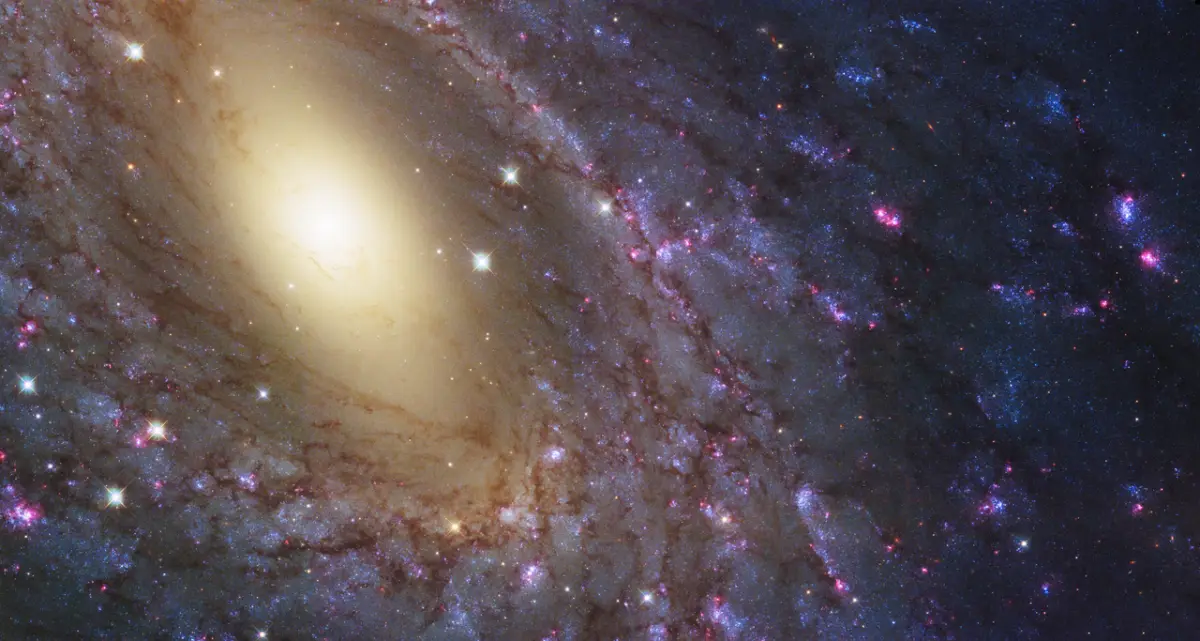
NGC 6744 by the Hubble Space Telescope (HST), image credit: Judy Schmidt, Legacy ExtraGalactic UV Survey (LEGUS) (CC BY 2.0)
Location
The Pavo Galaxy appears a little less than halfway from Peacock (Alpha Pavonis), the brightest star in Pavo, to Atria (Alpha Trianguli Australis), the lucida of Triangulum Australe. The galaxy appears a little north of the imaginary line connecting the two bright stars and almost directly south of the Pavo Globular Cluster (the Great Peacock Globular, NGC 6752), the fourth brightest globular cluster in the sky.
At declination -63° 51’, NGC 6744 is best seen from the southern hemisphere. It never rises above the horizon for observers north of the latitude 26° N and stays low in the sky from the northern tropical latitudes.
From locations south of the celestial equator, the galaxy can be seen in a small telescope.
The best time of the year to observe the Pavo Galaxy and other deep sky objects in Pavo is during the month of August, when the constellation appears higher in the sky in the early evening.
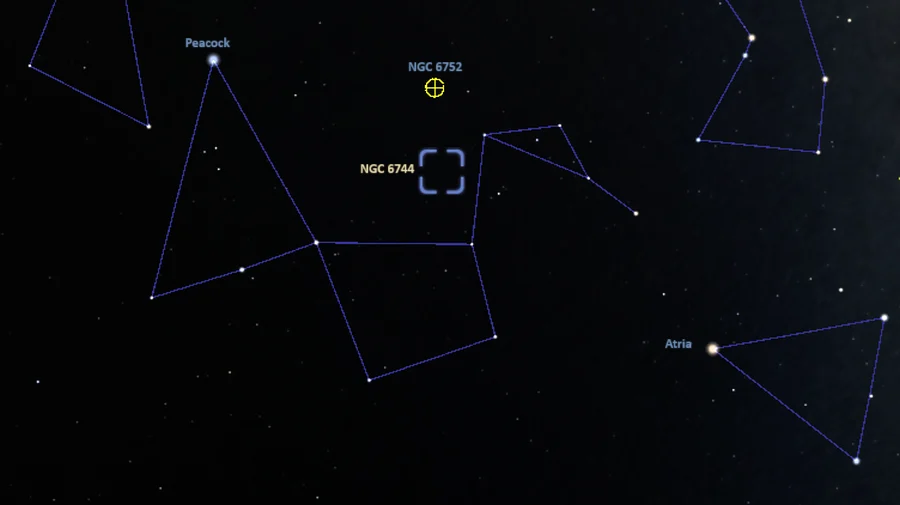
Pavo Galaxy (NGC 6744) location, image: Stellarium
Pavo Galaxy – NGC 6744
| Constellation | Pavo |
| Object type | Intermediate spiral galaxy |
| Morphological type | SAB(r)bc |
| Right ascension | 19h 09m 46.1335950504s |
| Declination | −63° 51′ 26.897079024″ |
| Apparent magnitude | 9.14 |
| Apparent size | 20.0′ × 12.9′ |
| Distance | 23.63 ± 1.68 million light-years (7.244 ± 0.514 megaparsecs) |
| Redshift | 0.002805 |
| Heliocentric radial velocity | 841 ± 2 km/s |
| Size | 171,800 light-years (52,680 parsecs) |
| Names and designations | Pavo Galaxy, NGC 6744, Caldwell 101, C101, LEDA 62836, PGC 62836, ESO 104-42, ESO 104- G 042, ESO-LV 104-0420, SGC 190501-6356.2, PSCz P19051-6357, IRAS 19051-6357, IRAS F19049-6357, 2MASX J19094609-6351271, AM 1905-635, 6dFGS gJ190946.1-635127, 2E 4184, 2E 1905.3-6354, FAUST 4420, HIPASS J1909-63a, Gaia DR3 6438574856277133568 |
Images
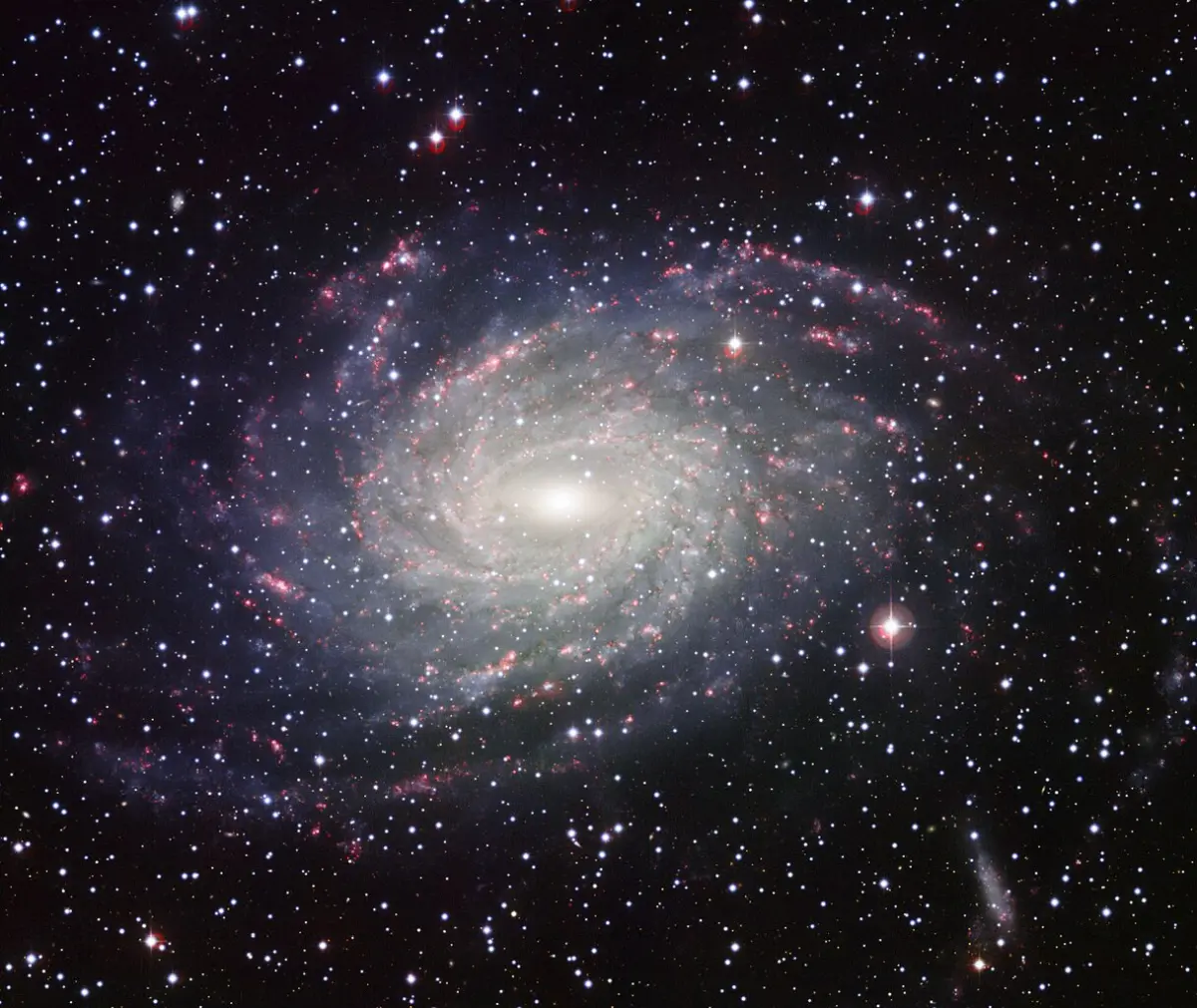
This picture of the nearby galaxy NGC 6744 was taken with the Wide Field Imager on the MPG/ESO 2.2-metre telescope at La Silla. The large spiral galaxy is similar to the Milky Way, making this image look like a picture postcard of our own galaxy sent from extragalactic space. The picture was created from exposures taken through four different filters that passed blue, yellow-green, red light, and the glow coming from hydrogen gas. These are shown in this picture as blue, green, orange and red, respectively. Image credit: ESO (CC BY 3.0)
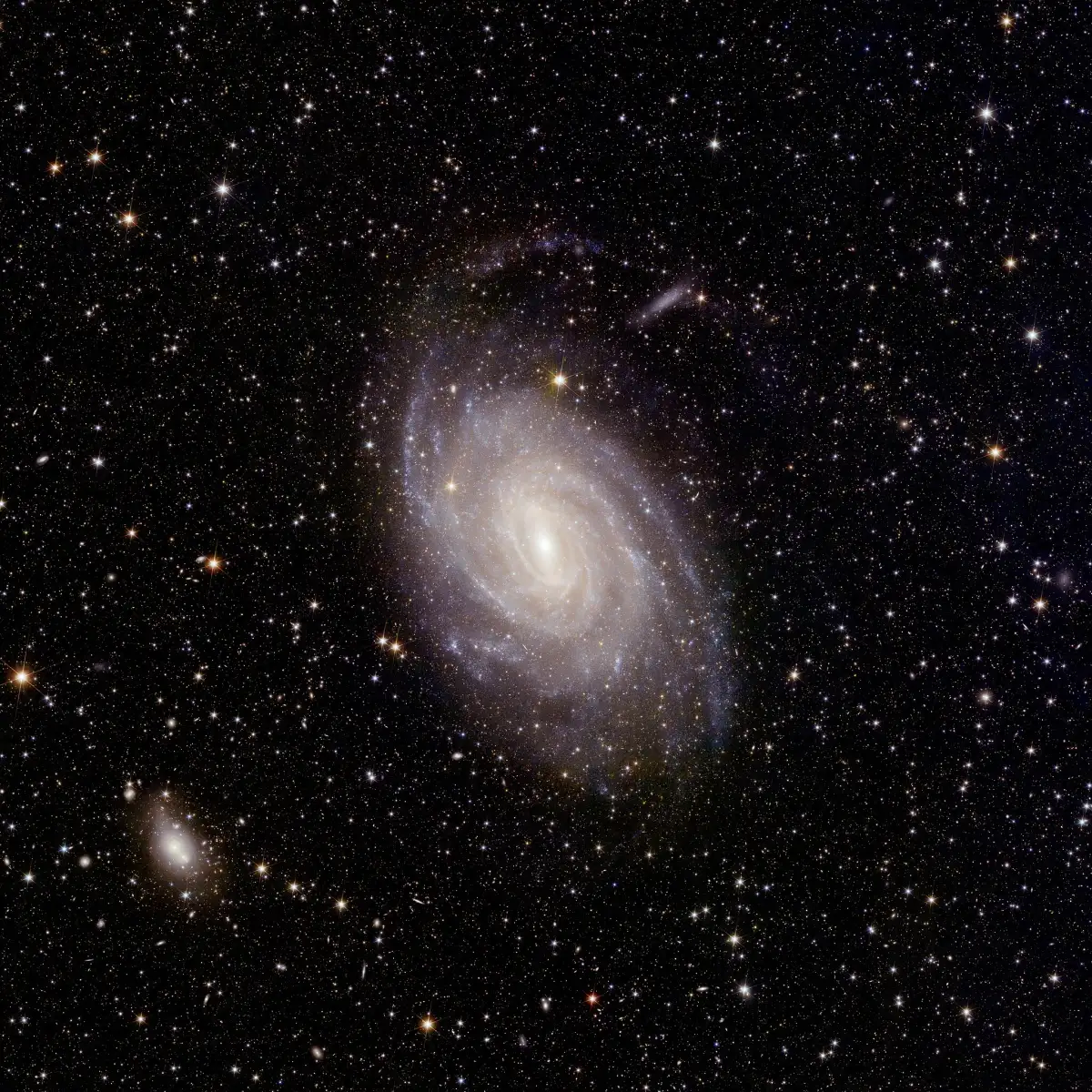
Here, Euclid captures NGC 6744, one of the largest spiral galaxies beyond our local patch of space. It’s a typical example of the type of galaxy currently forming most of the stars in the nearby Universe, making it a wonderful archetype to study with Euclid. Euclid’s large field-of-view covers the entire galaxy, revealing not only spiral structure on larger scales but also capturing exquisite detail on small spatial scales, and at a combination of wavelengths. This detail includes feather-like lanes of dust emerging as ‘spurs’ from the spiral arms, which Euclid is able to image with incredible clarity. Euclid’s observations will allow scientists to not only count individual stars within NGC 6744 but also trace the wider distribution of stars and dust in the galaxy, as well as mapping the dust associated with the gas that fuels new star formation. Forming stars is the main way by which galaxies grow and evolve, so these investigations are central to understanding galaxy evolution – and why our Universe looks the way it does today. Image credit: European Space Agency (CC BY-SA 3.0 IGO)
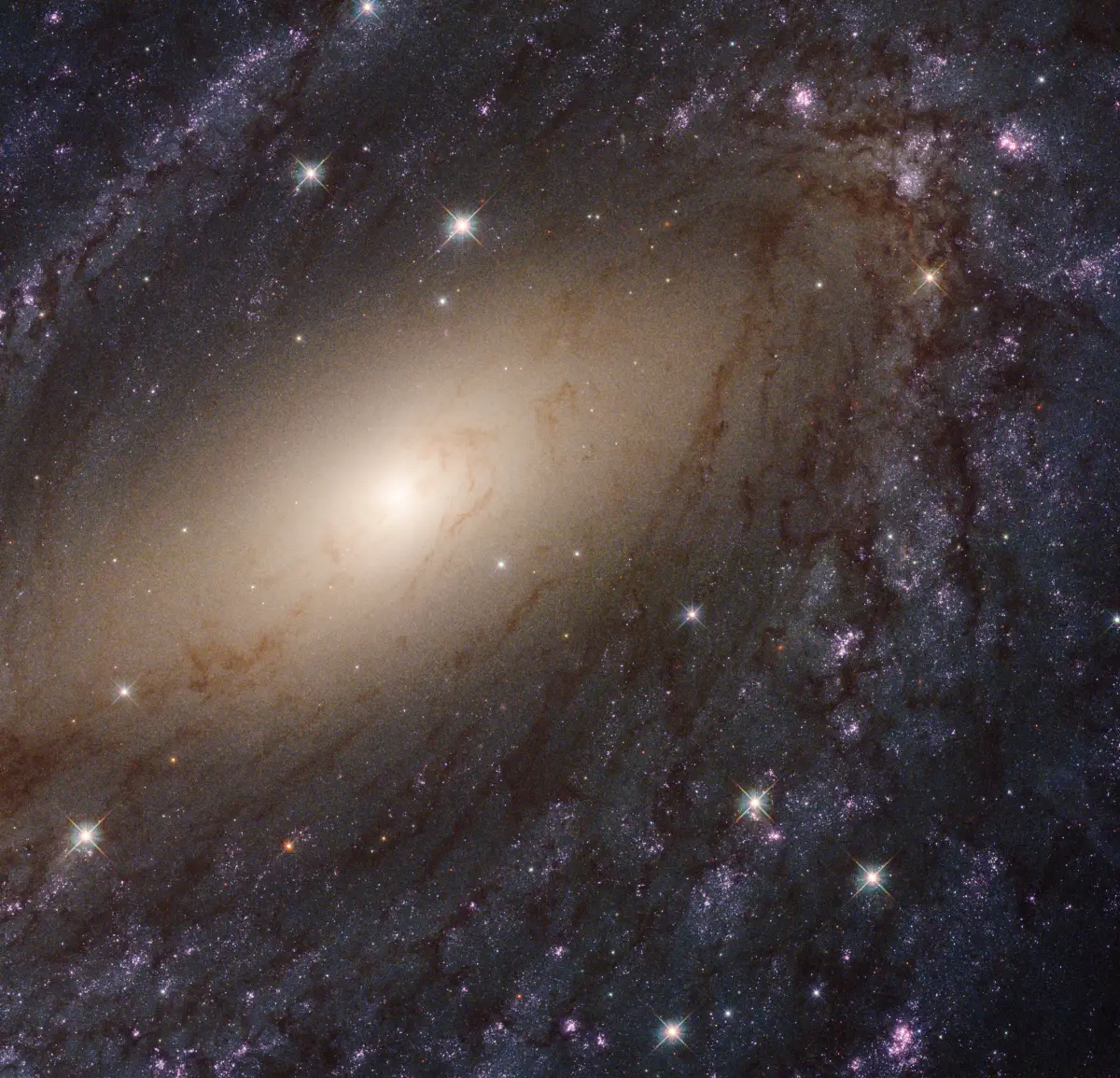
This image shows the galaxy NGC 6744, about 30 million light-years away. It is one of 50 galaxies observed as part of the Hubble Space Telescope’s Legacy ExtraGalactic UV Survey (LEGUS), the sharpest, most comprehensive ultraviolet-light survey of star-forming galaxies in the nearby Universe, offering an extensive resource for understanding the complexities of star formation and galaxy evolution. The image is a composite using both ultraviolet light and visible light, gathered with Hubble’s Wide Field Camera 3 and Advanced Camera for Surveys. Image: NASA, ESA, and the LEGUS team (CC BY 4.0)
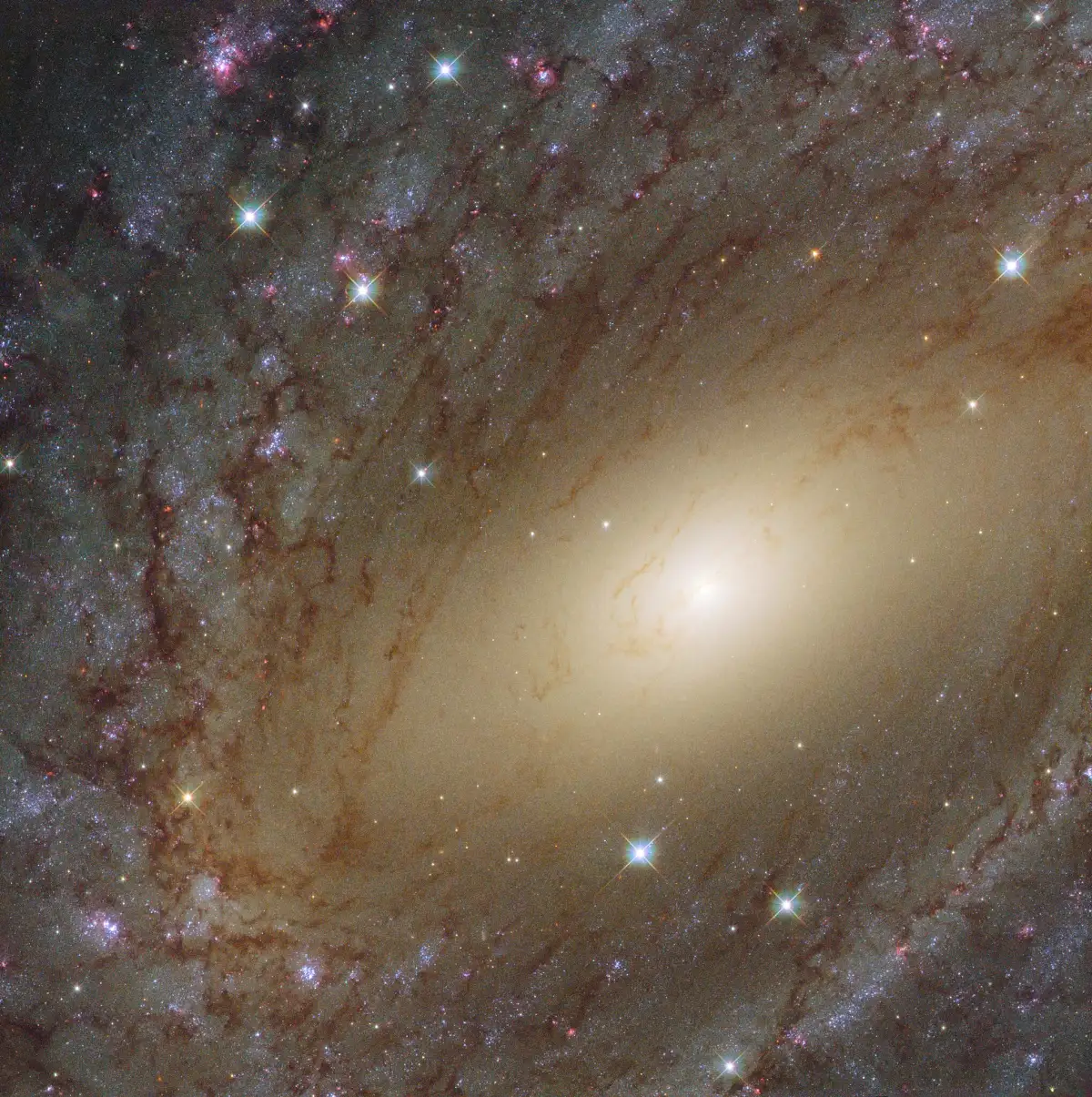
This image taken by the NASA/ESA Hubble Space Telescope’s Wide Field Camera 3 (WFC3) shows a beautiful spiral galaxy called NGC 6744. At first glance, it resembles our Milky Way albeit larger, measuring more than 200 000 light-years across compared to 100 000 light-year diameter for our home galaxy. NGC 6744 is similar to our home galaxy in more ways than one. Like the Milky Way, NGC 6744 has a prominent central region packed with old yellow stars. Moving away from the galactic core, one can see parts of the dusty spiral arms painted in shades of pink and blue; while the blue sites are full of young star clusters, the pink ones are regions of active star formation, indicating that the galaxy is still very lively. In 2005, a supernova, named 2005at, was discovered within NGC 6744, adding to the argument of this galaxy’s liveliness (not visible in this image). SN 2005at is a type Ic supernova, formed when a massive star collapses in itself and loses its hydrogen envelope. Image credit: European Space Agency (CC BY 4.0)
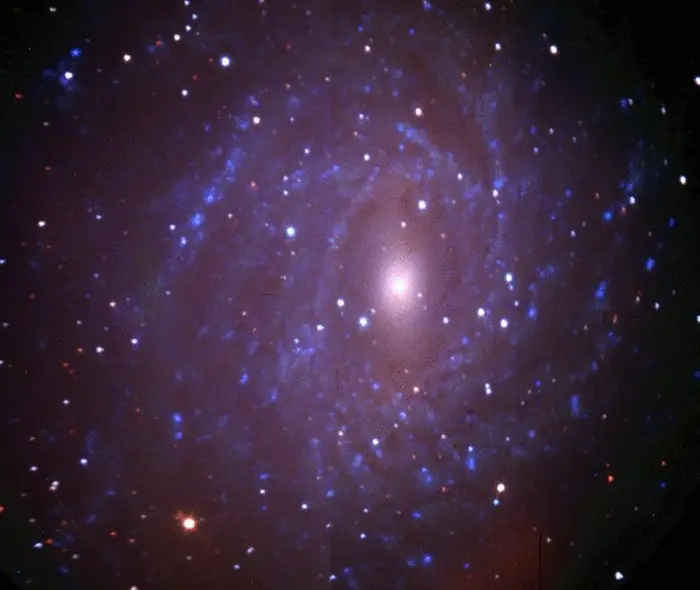
Giant spiral galaxy NGC 6744. Photo taken by the Southern African Large Telescope (SALT) (PD)
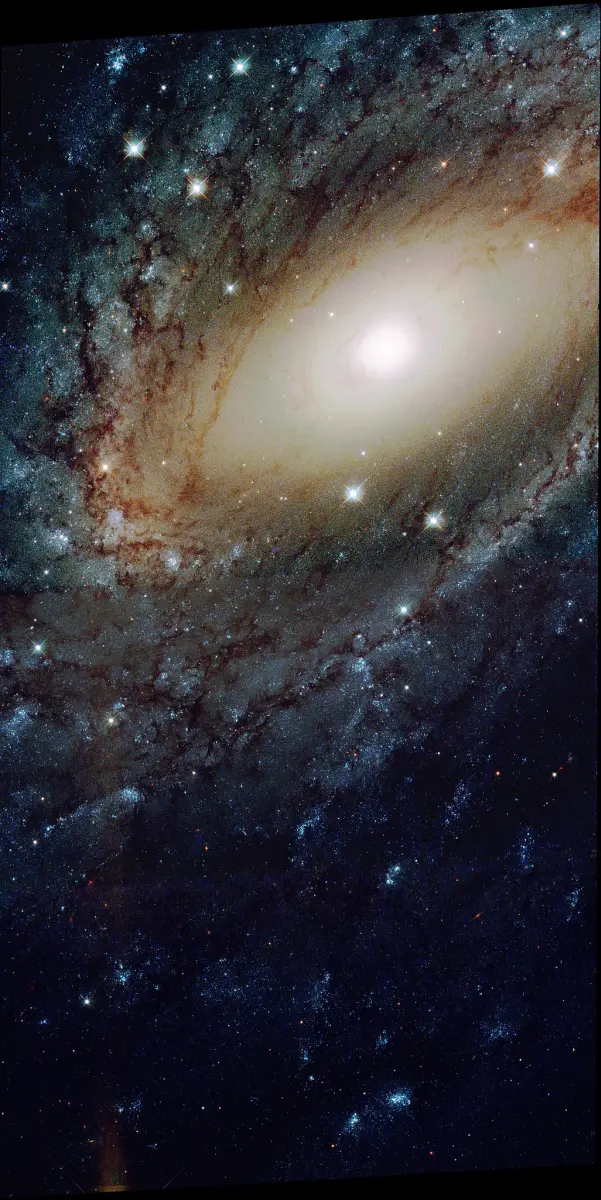
Pavo Galaxy captured by the Hubble Space Telescope, image credit: NASA/ESA – The Hubble Legacy Archive (HLA): Space Telescope Science Institute (STScI), the Space Telescope European Coordinating Facility (ST-ECF), and the Canadian Astronomy Data Centre (CADC) – zoranknez (Aladin software) (PD)